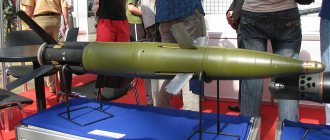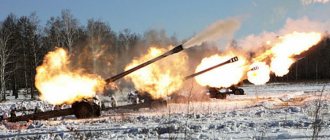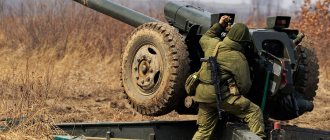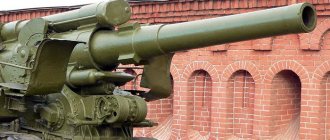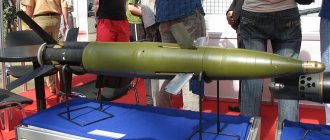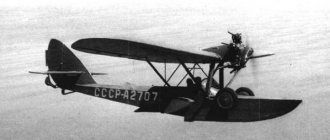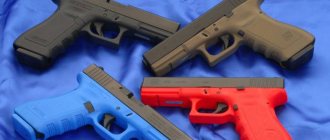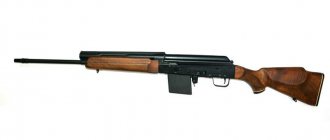The 152 mm Msta-B howitzer (2A65) can be considered the latest model in a long list of field howitzers of Soviet and now Russian design. However, relatively little is known about the 2A65 howitzer, also known under the designation “Msta-B” (in the West it is designated M1987), although recently it has been actively moving into the world arms market for possible export deliveries.
Howitzer Msta-B (2A65) - shooting video
The design of the 2A65 howitzer features several dramatic innovations compared to its predecessors, the most obvious of which is the long, thin barrel, estimated to be about 40 calibers long, equipped with a double-slit muzzle brake. It is also worth paying attention to the two-frame carriage, equipped with retractable additional wheels on each frame and a hydraulic jack with a platform under the pallet for hanging the wheels when firing. A crew of eight people brings the 2A65 howitzer into a combat position and collapses it in two to two and a half minutes. The loading mechanism and semi-automatic bolt allow the combat rate of fire to be increased to seven rounds per minute. The gun can be towed at a speed of 80 km/h on the highway and 20 km/h on a dirt road.
The Msta-B (2A65) howitzer can fire most existing types of 152 mm ammunition, but a new family of ammunition has been developed specifically for it and other similar guns. When using new types of ammunition, depending on the task, a preloaded cap of one of three types is selected. When firing a high-explosive fragmentation projectile of the latest generation, the firing range is 24,000 meters, and when using an OFS with a gas generator, the firing range increases to 29,000 meters. Other new types of 152 mm ammunition, first introduced with the 2A65, include cartridges containing 42 double-action (anti-personnel and armor-piercing) shrapnel grenades, each containing 45 grams of explosive.
Another new type of ammunition is a container that dispenses tiny radio transmitters designed to disrupt enemy communications. In addition, the 2A65 howitzer can fire the Krasnopol laser-guided armor-piercing projectile.
The barrel of the 2A65 howitzer is basically similar to that of the 2S19 self-propelled howitzer.
Msta-B ammunition
The howitzer fires with 152-mm separate-loading rounds developed both specifically for it (and for the 2S19 Msta-S), and used on the D-20, 2S3 Akatsiya, ML-20 howitzers.
- 3VOF58, 3VOF72, 3VOF73 rounds (with full, long-range and reduced charges, respectively) with a 3OF45 high-explosive fragmentation projectile - 3VOF91 round with a 3OF61 high-explosive fragmentation projectile with a bottom blowing gas generator and a long-range charge. - 3VOF96, 3VOF97, 3VOF98 rounds (with long-range, full and reduced charges) with a 3OF64 high-explosive fragmentation projectile. - 3VOF32, 3VOF33 rounds (with full and reduced charges) with a 3OF25 high-explosive fragmentation projectile. - 3VO28, 3VO29, 3VO30 rounds (with long-range, full and reduced charges) with a 3-O-23 cluster projectile with cumulative fragmentation combat elements. - 3VO13, 3VO14 rounds (with full and reduced charges) with a 3-O-13 cluster projectile with fragmentation warheads. - a 3VNS38 shot with a 3RB30-1-8 HF and VHF radio jamming projectile. — a shot with a 3NS30 active radar jamming projectile. - a 3VDTs8 shot with a smoke target designating projectile. — a 3VOF64 shot with a 3OF39 adjustable projectile with laser illumination of the 2K25 “Krasnopol” complex.
152-mm howitzer shell 2A65 "Msta-B" in the hands of a soldier
Foreign analogues.
Foreign artillery manufacturers are not sitting idle either. In the USA, after the modernization of the previous M109 design, a military weapon with very decent performance was obtained. The new M109A6 Palladin installation has a range of 30 km when firing a conventional high-explosive fragmentation projectile. The light American howitzer LW-155 with a caliber of 155 mm has excellent parameters. Work is underway to improve the effectiveness of projectiles. In the same States, the M795 155 mm caliber projectile was developed. Its advantage is the use of a new steel material, which, after rupture, tends to divide into much smaller fragments than before, which, due to their lower weight, have greater speed and become more dangerous. Among Russian analogues, we can note the howitzer produced in Yekaterinburg 2A61 “Pat-B” with a caliber of 155 mm. This artillery gun has been converted to the standard of howitzer shells from NATO countries.
Tactical and technical characteristics of the Msta-B howitzer
— Adopted: 1987 — Developed: from 1976 to 1986 — Manufacturer: Motovilikha plants — Total produced: more than 1200
Combat crew: 8 people
Caliber, mm: 152
Firing range of Msta-B
— Maximum firing range, km: OFS — 24.7; OFS with gas generator - 28.5 - Minimum firing range, km: 6.5
Rate of fire Msta-B
— Maximum rate of fire, shot/min: 7
— Initial speed of the OFS at a charge temperature of 15°C, m/s: 810 — Pressure in the CM at a barrel elevation angle of 0° MPa (kgf/cm2): 9.5±0.5 (95±5) — Elevation angle, deg .: −30…+70 — Horizontal guidance angle, degrees: −28…+28 — Firing accuracy: Range, V/X max: 1/363. On the side, Wb, m: 11
Weight Msta-B
— OFS weight, kg: 43.56 — Charge weight (long-range) kg: 12.05 — Howitzer weight in stowed position kg: 7000 — Barrel weight kg: 2599 — Muzzle brake weight kg: 170
Dimensions Msta-B
— Howitzer length in traveling position mm: 12700 — Howitzer width: 2500 — Howitzer height: 2950 — Ground clearance mm: 400 — Track width mm: 2150 — Barrel length with muzzle brake mm: 8130 — Barrel guide length mm: 6184 — Number of grooves: 48
— Height of the firing line mm: 1330 — Limit length of recoil on a long-range charge mm: 1000 — Amount of fluid in the recoil brake, l: 17.5 — Amount of fluid in the cradle casing, l: 10.5 — Amount of fluid in the knurling MPa (kgf/ cm2): 5.5±0.25 (55±2.5) — Amount of liquid in the multipliers l: 1.0
— Time to transfer the howitzer from traveling to combat position, min: 2—2.5 — Towing speed on dirt roads km/h: 60
[edit] History of creation
| This section is not completed. You will help the project by correcting and expanding it. |
The 152 mm Msta-B howitzer was developed under the leadership of the Chief Designer - G. I. Sergeev (special design bureau of the Barrikady Production Association (OKB-221), now the Titan Central Design Bureau).
R&D to create a towed 152 mm howitzer "Msta-B" began in 1976. Development goal: increasing the firing range, rate of fire, increasing the vertical guidance angle, increasing the effective action of the projectile at the target, maneuverability and other characteristics compared to the ML-20, D-1, D-20 guns.
The main focus during the design was to ensure high accuracy of howitzer fire through design measures. The layout of the main components of the howitzer is implemented taking into account the stability of the disturbing moments acting during firing. At the stage of designing and testing the gun, a study was carried out to select the optimal combination of geometric and design parameters of the projectile, which made it possible to ensure improved aerodynamic characteristics of the new high-explosive fragmentation projectile and stability along the trajectory, despite the significant length and long-range shape of the projectile.
In 1986, the 152 mm Msta-B howitzer was adopted by the Ground Forces.
Serial production began in 1987, and is currently in service with the Russian army and some CIS countries.
The howitzer implements the following design solutions:
- three-chamber muzzle brake with efficiency up to 63%;
- two-speed guidance mechanisms providing vertical guidance angles up to 70° and horizontal guidance on slopes up to 5°;
- loading mechanism with a spring-loaded rammer for shells cocked from recoil parts and a guide tray, driven by the bolt;
- automatic shutdown of wheel suspension when the frames are extended.
Photo Msta-B
Artillery tractor "Bear" based on the KamAZ-63501 chassis towing a 152-mm howitzer 2A65 "Msta-B"
Breech 2A65 "Msta-B"
[edit]Device and characteristics
The artillery part of the 2A65 "Msta-B" howitzer has a design similar to the artillery part of the 152-mm self-propelled howitzer 2S19 "Msta-S" (GRAU Index 2A64) and differs only in the presence of an ejector in the 2A64 for removing powder gases from the barrel after a shot.
The towed howitzer 2A65 is made according to the classic design of an artillery gun. It has a 53-caliber long monoblock barrel equipped with a three-chamber cast muzzle brake and a semi-automatic vertical wedge bolt, hydropneumatic recoil devices mounted above the barrel (liquid-cooled recoil brake and knurler), an upper machine with a shield cover to protect the crew and howitzer mechanisms from bullets and small fragments, lifting (two-speed, sector type), rotary (two-speed, screw) and balancing mechanisms, as well as a lower machine with two box-section frames and a two-wheeled chassis. A special pallet is mounted on the lower machine of the carriage, onto which the gun is lowered using a hydraulic jack when transferring it from the traveling position to the combat position. At the ends of the box frames, auxiliary metal rollers are mounted, with the help of which the gun can be rotated for firing in any desired position (without changing the position of the frames, the angle is 52°). In the vertical plane, the lifting mechanism of the upper machine ensures that the gun is aimed at the target in an angle range from -3.5° to +70°.
To increase the rate of fire and reduce crew fatigue, the gun is equipped with two throw-type spring rammers for delivering shells and charges.
When the gun is moved to the stowed position, the pallet is raised and attached to the barrel and cradle, the frames are shifted and connected to the towbar of the tractor. The standard means of transporting the howitzer is the Ural-4320 army truck with a 6x6 wheel arrangement. The sprung wheel travel of the gun allows it to be towed on the highway at speeds of up to 80 km/h, and on rough terrain - up to 20 km/h.
Calculation - 8 people.
